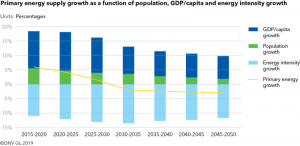by Sverre Alvik, via Energy Post

We can’t afford the energy transition? Next time you hear that from someone, perhaps you can show them this. Sverre Alvik at DNV GL explains that, according to their latest Energy Transition Outlook, although annual global energy expenditure will have to increase from $4.6tn in 2017 to $5.5tn in 2050, its share of growing world GDP will almost halve from 3.6% to 1.9%. That’s because continuing energy efficiency gains are making sure that total global energy costs are growing more slowly that global wealth. The difference is big enough such that peak energy will happen as soon as 2030, when global primary energy use will start to reduce as energy intensity improvements exceed the sum of population and economic growth. Alvik sets out what’s included in their strict definition of “total energy costs”, noting that even if it’s extended to include other things, like subsidies, the effect on the totals is too small to change the conclusions. So if the transition is not happening fast enough, the savings described here can be deployed to speed it up and meet the Paris goals.
It is not too good to be true, it is the economic reality that lies ahead of us. The energy transition facing us in the coming decades is an affordable one. In fact, the future energy system is not only affordable, it is cheaper than the energy system we have today. And this creates an opportunity to invest more to achieve the future we want.
Let me be more precise: in just one generation, humanity will be spending a much lower share of its GDP on energy than it does today. The main reason is not energy prices, but energy efficiency. Whether you believe in the phenomenon of peak energy, as DNV GL does, or just increased efficiency, the conclusion is the same, and it is robust.